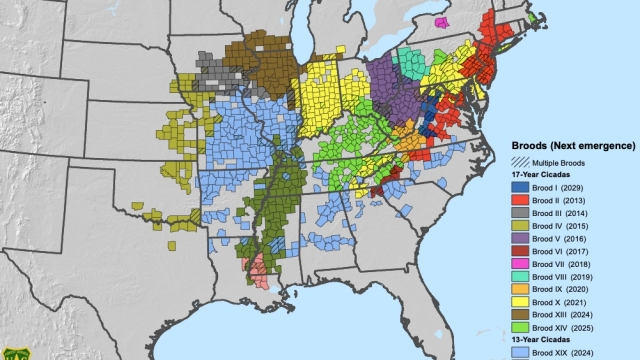Any day now, two massive broods of cicadas will emerge from the ground in a double emergence event that hasn’t happened in over 200 years. Billions — maybe even trillions — of these insects will be flying around, and now a map from the U.S. Department of Agriculture shows us exactly where this “cicada-geddon” will happen.
The two groups are Brood XIII and Brood XIX. Cicadas have a periodical life cycle, only emerging from below the surface when they reach adulthood and temperatures are right. Some take 13 years to become adults, while others take 17 years.
It is a rare event for cicadas with a 13-year life cycle and a 17-year life cycle to reach adulthood at the same time. Experts said this event will not happen again until 2245.
SEE MORE: Study finds cicadas could project high-speed jets of urine at you
Brood XIII (represented by a brown/green color on the USDA map) consists of three species and has a 17-year life cycle, according to the blog Cicada Mania. This group will be seen in parts of Iowa, Illinois, Indiana and Wisconsin and near Lake Michigan.
Expect the suburbs of Chicago to be noisy with their mating call during the summer months.
Brood XIX (seen in light blue on the USDA map) has a 13-year life cycle ,and its four species will be seen more widespread across the U.S. These cicadas will resurrect in Alabama, Missouri, Mississippi, Tennessee and parts of Arkansas, Georgia, Iowa, Illinois, Indiana, Kentucky, Louisiana, Maryland, North and South Carolina, Oklahoma and Virginia.
Even though the massive amount of cicadas may sound scary, the insects don’t bite or sting and are not hazardous to people or pets.
If you’re worried about any impact your plants and trees may have from the cicadas, the USDA Forest Service has some specific recommendations.
The periodical broods, which are dark colored with red eyes, shouldn’t be confused with annual cicadas that are green with black eyes. Adult cicadas can live up to six weeks as they mate and lay eggs for the next broods.
Trending stories at Scrippsnews.com



